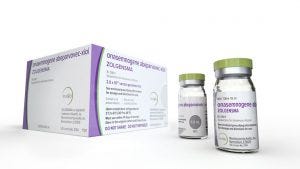Content Spotlight
Podcast: MilliporeSigma says education vital to creating unbreakable chain for sustainability
MilliporeSigma discusses the importance of people, education, and the benefits of embracing discomfort to bolster sustainability efforts.
June 10, 2019

Making Zolgensma, the new “world’s most expensive drug,” is a month-long process that depends on vector tech licensed from Regenxbio.
Zolgensma is a gene therapy. It is designed to halt progressive spinal muscular atrophy (SMA) – motor neurone loss and muscle wasting – in people who have a defective version of the gene SMN1.
The drug addresses the underlying causes of SMA according to Novartis spokesman Eric Althoff. He told us, “Zolgensma provides a functional copy of the human SMN gene to halt disease progression through sustained SMN protein expression.

“It is delivered via an adeno-associated virus (AAV) vector 9, AAV9, which is able to cross the blood-brain barrier to deliver a functional copy of the human SMN1 gene to the patient’s CNS – including brain and spinal cord motor neurons,” he said.
Zolgensma hit the headlines last month after the US Food and Drug Administration (FDA) approved it for the treatment of SMA in kids up to the age of two.
Some publications hailed Zolgensma as a breakthrough, predicting patients and parents would welcome an alternative to Biogen’s Spinraza (nusinersen), the only disease modifying treatment currently on the market.
However, most media coverage focused on the drug’s $2.1m price tag, setting it in the context of the wider debate about pharmaceutical prices and rare disease therapies.
Novartis has defended its position. The Swiss firm argued the cost of a single infusion of Zolgensma compares favourably with the cost of the multiple administrations required by the Biogen product.
Zolgensma was developed by AveXis, a Chicago-headquartered biotech that Novartis bought in 2018 for $8.7bn.
AveXis’ intellectual property holdings and licensing agreements are key according to Althoff, who cites the firm’s deal with Rockville, Maryland-based Regenxbio as an example.
He told us, “AveXis has a worldwide license from Regenexbio for any recombinant AAV vector in its intellectual property portfolio for the in vivo gene therapy treatment of SMA in humans, including AAV9.”
In common with the production other viral vectors, the vectors used to make Zolgensma are produced in adherent cell lines.
Working with adherent cell lines requires specialist technologies and systems. For example, stirred tank bioreactors are better suited to the growth of cells in suspension rather than those that are fixed.
Production of a single Zolgensma batch takes 30-days Althoff told us, explaining that after cell expansion, triple transfection of HEK293 cells is used to make the adeno associated virus (AAV) vectors.
Downstream processes consist of a series of capture and filtration steps used to achieve the desired impurity profile and full/empty capsid ratio all of which require specialist technologies.
“We complete the entire process in-house” Althoff said, adding “The process takes approximately 30 days start to finish. Product can be stored for 12 months.”
You May Also Like